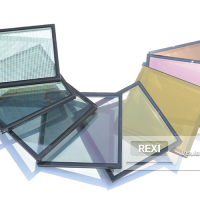Date: 12 April 2013
The tighter requirements of the new EnEV have dramatically increased the popularity of energy-efficient insulating glass units (IGUs) – but the greater weight of these units means frames and hardware are exposed to heavier loads, and installers face an increased risk of accidents and health problems.The mass per unit area of IGUs can be reduced by using thinner glass, or employing transparent plastic glazing sheet material or interlayers. The research project described here, which was funded by the Zukunft Bau research initiative with support from the German Flat Glass Association, Isophon Glas, Southwall Europe, and Winterglas, has produced some interesting results in this regard.
As IGUs grow in size and popularity, it makes sense to attempt to reduce their weight. The research project "Mass per unit area of insulating glass units" looked at possible design solutions for achieving this: for example, using thinner glass, or employing transparent plastic glazing sheet material or interlayers.
The resulting research report presents "contour plot" diagrams for a range of pane configurations and formats involving thin glass panes, showing the bending tensile stress and deflection resulting from exposure to climate and wind loads, as a function of edge length. Among other things, the report compares the linear Kirchhoff plate theory with a non-linear approach that takes account of membrane stresses.
Other interesting components include analyses of material properties and compatibilities, ageing behaviour, and structural fixing details, and the determination of the boundary conditions affecting the fitness for use of plastic sheet glazing material and interlayers in the cavity. The research project yielded the following general conclusions, which are presented in detail in the final report in the form of diagrams and tables:
- In terms of sizing, wind load is generally the critical factor in large insulating glass units; the non-linear theory produced significantly lower stress and deflection values than the Kirchhoff theory. In small insulating glass units, climate load is the critical factor; there is no benefit in using the non-linear theory here. The same applies to long, narrow units.
- For panes of thickness 4 mm and 3 mm with a short edge (approx. <65 cm), toughening is necessary. Generally, however, the need to toughen thin panes is no greater than the need to toughen 4 mm float glass – though specific pane handling requirements and thermal loads can render toughening necessary after all.
- The spectral transmittance and reflectance of thermally-toughened glass panes are comparable to those of normal float glass.
- Configurations involving an interlayer in place of a mid-pane are complex systems. In order to verify the suitability of various combinations of interlayers, sealants and spacers, a range of investigative methods is needed. The requirements of EN 1279 concerning gas leakage rate and moisture penetration can essentially be met. No fogging occurred when the test temperature was increased.
- If transparent plastic sheet glazing material is used as a mid-pane, special support details are required which permit thermal expansion and elongation without placing strain on the edge seal. In both of the plastic types investigated – polycarbonate and PMMA – no fogging occurred even when the test temperature was increased. To prevent the build-up of moisture released from the plastic sheet glazing material in the cavity, the glazing material must either be dried prior to installation, or the quantity of desiccant used must be adapted accordingly.
- The configurations with a reduced mass per unit area studied in the research project were found to display a similar thermal transmittance, total energy transmittance and light transmittance to conventional IGUs.
- Because of their small mass, thin glass panes in symmetrical configurations essentially have a lower airborne sound insulation effect than conventional panes. But it is possible to compensate for this detrimental effect by configuring the IGU asymmetrically. Regardless of whether the mid-pane is made from thin glass, an interlayer, or transparent plastic sheet glazing material, it will have no significant impact on airborne sound insulation.
The short research report, entitled "Mass per unit area of insulating glass units – Energy efficient insulating glass units – study of technical measures for reducing the mass per unit area", is available to download from the Literature section of the ift Rosenheim website under "Research reports". The ift Rosenheim offers a comprehensive range of tests, calculations and documentary evidence for new and innovative IGU designs.
The pictures are available in the ift picture_library.
UserFiles/PI130366_Research_results_reducing_mass_per_unit_area(2).pdf


















Add new comment